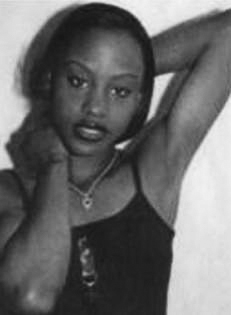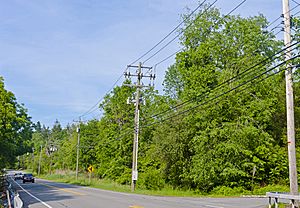Ramona Moore homicide facts for kids
Quick facts for kids 
An image of Moore distributed by police and prosecutors seeking her whereabouts
after her disappearance in 2012 |
|
| Missing | July 31, 2012 |
|---|---|
| Arrests | Nasean Bonie |
| Convicted | Bonie |
| Charges | Second-degree murder |
| Verdict | Guilty |
| Convictions | Manslaughter |
On April 21, 2015, the remains of a woman found in South Blooming Grove, New York, were identified. They belonged to Ramona Moore. She was 35 years old. Ramona was last seen on July 31, 2012. She was going back into her apartment in the Bronx, New York City.
In 2014, New York City police accused Nasean Bonie of causing her disappearance. Bonie was the building superintendent. Police suspected Bonie early in the investigation. Friends said Ramona and Bonie had disagreements about rent.
On the night Ramona vanished, clues suggested Bonie might have been hiding something. Police searched the basement of Ramona's apartment in 2013. After this, Bonie claimed officers stole money. He said he was accused of the crime as revenge.
In 2014, federal marshals arrested Bonie in Pennsylvania. He reportedly said that without a body, he could not be charged. His trial was set to begin in April 2015. This was just days after Ramona's body was found.
The trial was put on hold. This allowed medical examiners to find out how Ramona died. Bonie was facing charges for an attack on his wife. Shortly after Ramona's body was found, Bonie was found guilty of attacking his wife. He was sentenced to four years in prison for that crime.
Bonie's lawyers showed records that Ramona had paid her rent. Prosecutors said the dispute was not about rent. They believed Bonie wanted Ramona to file false papers. This would have increased her housing help. To prove this, they asked for a TV interview Bonie gave. The TV channel did not want to give up the full interview.
A judge said the channel had to let him review the video. The channel is appealing this decision. A trial in July 2016 lasted a month. The jury found Bonie not guilty of murder. But they did find him guilty of manslaughter, a less serious charge.
Contents
Ramona Moore's Life
In the spring of 2012, Ramona Moore was 35 years old. She was a Guyanese American. She lived on Jefferson Place in the Bronx neighborhood of Claremont. This was near Crotona Park. She lived in a house that was part of a housing program.
She rented the house from Krystal Campbell and Nasean Bonie. Krystal owned the houses. But her husband, Nasean Bonie, managed them. He was the building superintendent.
Both Ramona and Bonie had legal issues at the time. Three of Ramona's four children lived with her. They had been placed in foster care earlier that year. The city's Administration for Children's Services (ACS) had investigated. They found that the children were sometimes neglected. They missed school and were left alone. Ramona did not have a job. She hoped her oldest child, Rashina, could move back. This would happen after Ramona finished court-ordered programs.
On July 12, 2012, Bonie attacked his wife. He used a tray table, his belt, and his fists. His wife's skull was fractured. Bonie was arrested and charged with a serious crime. Around this time, Ramona told a neighbor that Bonie was trying to get money from her. He was doing this by pretending it was for rent.
Ramona's Disappearance
Ramona was talking with a neighbor on the evening of July 31, 2012. She had already told this neighbor about Bonie's demands for money. Ramona had called 9-1-1 about Bonie twice that day. She was eating a mango and offered one to her neighbor.
Ramona went back into her house to get the fruit. She never came out. No one who has spoken publicly saw her alive again after that. Ramona was reported missing several days later. Her absence was longer than usual. The neighbor later told police she heard Ramona arguing with Bonie. After a loud noise, the argument stopped.
The Police Investigation
New York City police detectives began searching Ramona's apartment. Her leaving seemed sudden and unplanned. Her cat had not been fed. No plans were made for it. Her medicine for lupus was left behind. Ramona had not gotten more pills from the pharmacy. Ramona never missed family events, like her children's birthdays.
Bonie told police he had a dispute with Ramona about her rent. He said she was a difficult tenant. He told detectives she let different men into her apartment at all hours. Soon after she disappeared, he threw out her things. He then rented the house to a new tenant.
The police investigation got tips from other neighbors. One detective called them "watchers." They described things Bonie did. One neighbor saw Bonie leave the house with a large garbage container. He put it in a vehicle. Another saw him return in the same vehicle later that night. Police began to think it was a crime, even though it was still a missing-persons case.
Police checked Bonie's cell phone records. They found calls from towers in Orange and Rockland counties. These are northwest of the city. Bonie has relatives there. A detective worked with an expert. They narrowed a search area based on Bonie's travel times. They searched road sides, especially in Harriman State Park. But they did not find Ramona's body.
Police eventually got a search warrant for the basement. They searched it in April 2013. The basement floor was covered in sewage. A dog was loose there. Officers had to calm it with a tranquilizer dart. In a toilet, they found half a bag of charcoal. They believed it was flushed to cause a backup and destroy clues.
A camera crew filmed the search for a news channel. Bonie was angry when he returned. He said police were bothering him. He claimed police stole $40,000 cash from the basement. The police department denied this. Bonie filed a lawsuit about the missing money.
Bonie's Arrest
Police did not say if the basement search found anything important. But almost a year later, in May 2014, prosecutors presented evidence. A grand jury then accused Bonie of serious charges. An arrest warrant was issued for him. A newspaper reported that someone told police Bonie admitted to being involved in Ramona's disappearance.
Bonie had moved to Mechanicsburg, Pennsylvania. Federal marshals arrested him. He reportedly told them, "You can't charge me with murder without a body." Back in the Bronx, a judge ordered Bonie to be held without bail.
Since the early 1800s, courts have tried many cases without a body. Bonie's case would have been the first in the Bronx. A former prosecutor said it's harder to prove a case without a body. But convictions have happened before. Prosecutors believed they could convict Bonie if other evidence was strong.
In late 2014, a news channel aired an interview with Bonie. He was in jail. He said he had nothing to do with Ramona's disappearance or death. He said she was a good tenant who paid rent on time. He asked why he would have helped police if he had done something wrong. He said they only suspected him after he sued them.
Ramona's Body Is Found
In April 2015, utility workers were clearing trees. They were working along New York State Route 208 in South Blooming Grove, New York. This is a village in Orange County. They found human skeletal remains about 30 feet from the road. They called New York State Police. The remains were taken to a medical examiner.
Four days later, dental records showed the bones belonged to Ramona. Bonie was known to have a friend near where the remains were found. It was not known if Ramona was killed in the Bronx or Orange County. Bonie pleaded not guilty to the charges. He denied being involved in Ramona's death.
The Trial
Bonie's trial was supposed to start the week after the body was found. Instead, it was delayed. A forensic anthropologist examined the bones. This was to find out the cause of death. The report was expected by June.
The day after Ramona's body was identified, Bonie was in court. He faced the assault case against his wife. He pleaded guilty to assault. He was sentenced to four years in prison. A judge called his crime "a multi-weapon attack on a woman."
In September 2015, prosecutors asked the news channel for all footage of Bonie's interview. The channel said they would give the broadcast part, but not the unedited parts. They cited state shield laws. Prosecutors tried to make the channel give the footage. The channel formally tried to stop this request.
At a hearing, the channel argued the unedited video had nothing new. Prosecutors said they wanted to see if Bonie had said anything about money. This was to support their idea that money was a reason for the crime.
Around the time Ramona's body was found, Bonie's lawyers got records. These showed Ramona paid her rent on time. This made the prosecution's money theory seem weaker. Prosecutors said their theory was not about unpaid rent. They believed Bonie pressured Ramona to file false housing papers. This would let him collect more rent. They wanted to see if Bonie said anything in the interview that supported or went against this idea.
The judge ruled that the news channel had to give the full interview. The judge said prosecutors wanted to see if Bonie made any important statements. The news reporter's story said Bonie spoke positively about Ramona. Even Bonie's lawyers agreed the housing papers issue was important. The judge did not think Bonie was promised secrecy by the news channel. There was no other way for the state to find out what he might have said. The judge said he would review the interview himself. He would only give the prosecution parts about Bonie and Ramona's landlord-tenant relationship or the housing papers.
The decision was paused for an appeal. The news channel said it would appeal. Their lawyer said this was prosecutors going too far. He said it was using a reporter's work as a police tool. He said this is what the shield law prevents.
In July 2016, Bonie's trial happened. The prosecution had 20 witnesses. At the end, the jury found Bonie not guilty of murder. But they found him guilty of manslaughter.
The next month, Bonie was sentenced to 25 years in prison. This was the maximum sentence. Bonie said he was innocent before the sentencing. He said his life had been taken by the police. He also said the prosecutor's office was covering up lies. Ramona's sister said Bonie was a "menace to society." She said he should never be free again. He was sent back to Attica Correctional Facility.
Images for kids




